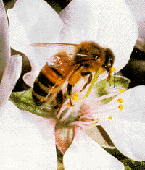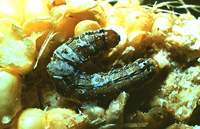The honey bee is a helpful insect because it pollinates the farmer's crops while gathering its food. Pollination allows the plant to create its seeds, such as grains of wheat or kernels of corn. Many farmers keep beehives on their farms to ensure the pollination of their crops because there are very few honey bees left in the wild. Of course, farmers also keep bees to produce beeswax and honey! Spiders, ladybugs, wasps, dragonflies, and praying mantises are also helpful because they eat harmful insects
| What insects do you like and are helpful to you? |

Photo from Mann Lake, Ltd.



